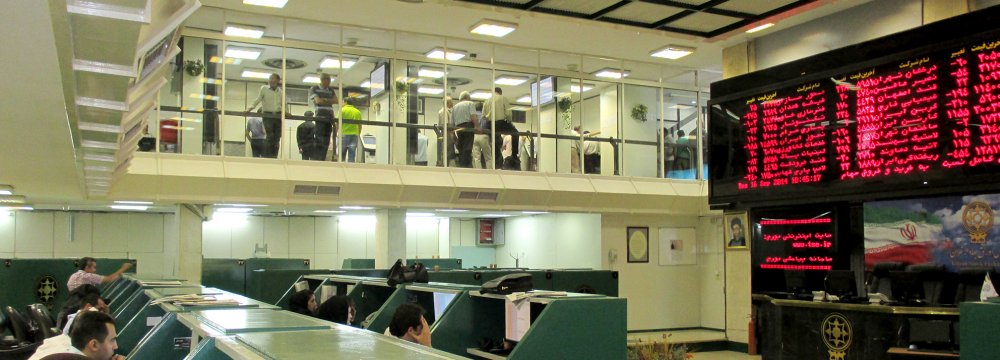Spring-time rallies within the first five working days of the Iranian new year (started March 21) at the Tehran Stock Exchange (TSE) has evaporated massive losses incurred by refining companies' comeback, as upbeat news over a deal between Iran and the P5+1 triggered bullish trend at the equity market.
The TSE's overall index has soared more than 5 percent since March 25, with upbeat news convincing investors to flock back to the equity market, as a more vigorous economy appears to be emerging.
According to the TSE data, the TEDPIX piled up gains and climbed 2,843 points or 4.52 percent to stand at 65,728 during the week that ended March 31. The first market index gained 2,394 points or 5.25 percent to stand at 47,994.8. The second market index was up 3,647 points or 2.84 percent to end at 132,032.8. The free float index rose 3,392 points or 4.67 percent to 76,066.7. The industry index pulled higher 2,414 points or 4.68 percent to finish at 53,959.6. The financial index surged 5,074 points or 3.73 percent to 141,455.6, and the blue-chip index also was up 161 points or 5.55 percent to 3,057.5.
More than 3.6 billion shares changed hands, valued at around 6.4 trillion rials, with many investors lining up to pour money at the equity market with the aim of recovering their losses inflicted due to prevailing bearish sentiment last year.
Savvy investors have garnered rock-bottom shares during the past few days, and veteran investors have preserved their portfolios.
Iran and world powers took their biggest step toward ending a decade-old nuclear standoff on Thursday, saying they agreed on the main outlines of an accord after more than a week of grueling talks, Bloomberg reported.
The deal announced in Lausanne, Switzerland doesn’t commit either side to immediate action, and leaves three more months for diplomats to fill in details. A news conference in Switzerland was held on Thursday around 1:30 p.m. Eastern Time to announce the deal, but June 30 remains the final deadline for a comprehensive deal to be reached.
Foreign Investors En Route
The Thursday breakthrough is expected to open up the gates to untapped markets in Iran for frontier investors.
As was expected before, the deal has paved the way for international investors to work a contingency plan for the coming months.
Western investors are most likely to queue up to invest in Iran; and the first stop for the majority of their investment is expected to head to the TSE.
The stock market is especially attractive as it is relatively large and liquid and could be an interesting part of a frontier fund. The P/E (price-to-earnings) valuations ranging between 7 times and 11 times for many of these companies look attractive, the CNBC reported.
Tehran’s stock exchange lists 340 companies on its website with a combined market capitalization of $104.21 billion. The country has the second largest population in the Middle East and North Africa region, according to the World Bank, with 80 million people – three times the regional average. It has the fourth biggest oil reserves in the world, according to the US Energy Information Administration, and the second biggest natural gas reserves; second only to Russia.
“Iran has a unique combination of frontier and developed characteristics that make it potentially compelling,” Wall Street Journal quoted Alison Graham, chief investment officer of New York-based frontier-markets investor Voltan Capital Management LLC as saying. “It has a well-educated population, a large middle class, a substantial industrial base and has made progress in dismantling subsidies to get its macro house in order. At the same time, growth, valuations and potential investment upside are similar to frontier countries at a much earlier stage of development,” she said adding that: “Anyone devoting substantial resources to potential Iranian investments at this point is getting ahead of himself.”
Before investing tens of millions of dollars in Iran starting in 2008, Juha Kojonen, head of Confido Capital OY in Helsinki, said: “I didn’t even know Iran had a stock market.” The company, which manages about $200 million, is one of just a handful of westerners with money still in the market.
Potential investors point to a plethora of administrative and infrastructure deficiencies that would need to be addressed before a lifting of sanctions would spur large-scale western investment. Lack of global custodians and dearth of meaningful corporate research are among these deficiencies to name a few.
Some western fund managers are already planning. Financial-services companies in Tehran, which had kept a low profile for years, are hustling to keep up with the demand from western investors wanting to visit and learn more. “I’m meeting fund managers every day,” said Reza Soltanzadeh, chief executive of Iran Industries Investment Co. in Tehran.
Bottoms-up analysis indicates that a drastic change is expected to happen in Iran’s economy, and the TSE, which will most probably be the first destination to host the flock of investors, is likely to boom in the mid-run.





